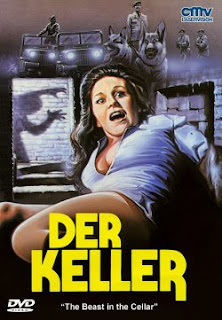FRIGHT (1971)
STRAW DOGS (1971)
Susan George in Pete Walker's DIE SCREAMING, MARIANNE. George was astutely described by Leslie Halliwell as "British leading lady, former child actress; usually typed as sexpot."
DIE SCREAMING, MARIANNE is an antiseptic mystery thriller which never lives up to its title. The film was a troubled production which was suspended because of frictions between its young cast, according to director Pete Walker, yet screenwriter Murray Smith suggests the problems were more financial. Whatever the reason, the meandering script surprisingly lacks nudity, sex and violence after an appealingly garish opening credits sequence, which sees George gyrating to the theme music in a black bikini against a glowing red backdrop. With its extensive location shooting its all too glossy and respectable to ever create the erotic charge Walker yearned for, though the incestial relationship between The Judge and Hildegarde provides some memorable tensions ("I ought to spank you - only you'd like it.")
"The scream you can hear is your own." The scariest thing about FRIGHT is that the dream sequence from THE PLAGUE OF THE ZOMBIES plays on television. This is the cover to Optimum's R2 DVD, released in January 2010.
One of the first films to explore a babysitter tormented by an escaped psychopath, Peter Collinson's FRIGHT is another dull affair. Amanda (George) is hired as a babysitter for Tara (Tara Collinson, the director's son), the infant of Jim and Helen Lloyd (George Cole and Honor Blackman). But unknown to Amanda, Helen and Jim are not a married couple heading out to celebrate their anniversary, but are going to meet a psychologist to discuss Helen’s husband Brian (Ian Bannen), who has been placed in an asylum. Back at the house, Amanda is harassed by would-be boyfriend Chris (Dennis Waterman), and spooked by various noises. When she finds Chris battered unconscious, in her panic she lets in an apparently friendly neighbour. But that person is in fact Brian, who has escaped from custody.
One of the first films to explore a babysitter tormented by an escaped psychopath, Peter Collinson's FRIGHT is another dull affair. Amanda (George) is hired as a babysitter for Tara (Tara Collinson, the director's son), the infant of Jim and Helen Lloyd (George Cole and Honor Blackman). But unknown to Amanda, Helen and Jim are not a married couple heading out to celebrate their anniversary, but are going to meet a psychologist to discuss Helen’s husband Brian (Ian Bannen), who has been placed in an asylum. Back at the house, Amanda is harassed by would-be boyfriend Chris (Dennis Waterman), and spooked by various noises. When she finds Chris battered unconscious, in her panic she lets in an apparently friendly neighbour. But that person is in fact Brian, who has escaped from custody.
Amanda is a plucky heroine, paving the way for the multitude of final girls to come, and Tudor Gates' script deals with a good many plot elements that would become staples of the bludgeoning slasher genre: the beleaguered babysitter, the boyfriend playing pranks and/or pestering the heroine for sex, the friendly neighbour/visitor who may not be what they seem, phone cords cut et al. Yet it all feels too dated; 'Nanette' sings a tepid song (Ladybird) over the opening titles, Waterman is embarrassing in pink flares and cardigan ("Oi reckon you've got a lovely pair of Bristols"), and Bannen overacts to a point of parody (in his Video Watchdog review, Charlie Largent is more lenient, likening his growls to Karloff while referencing SON OF FRANKENSTEIN). The film also has the most ineffective police force you're ever likely to see, and it is amusing to note that the Constable is played by Roger Lloyd ('Trigger') Pack.
George in STRAW DOGS. Sam Peckinpah's Westcountry Western was accused of glamouring rape and glorifying misogynistic sadism.
Cast on the strength of these minor outings, George gives an extraordinary performance as Amy in Sam Peckinpah's STRAW DOGS. The film exists at the heart of Amy's world, a rural West of England of which her and American mathematician husband David (Dustin Hoffman) have relocated. The couple soon realise that his intellect and her girl next door image cause resentment, factors festering with the couple's own marital problems. In the final act, David runs over suspected paedophile Henry (an uncredited David Warner) and takes him home, unaware that he has broken the neck of a flirtatious teenager. When the girl's drunken father (Peter Vaughan) discovers that the couple are hiding Henry, a whiskey-fuelled posses besiege David and Amy's abode of Trencher's Farm.
Shot by John Coquillon - who similarly gave us a tableaux of rural English violence for WITCHFINDER GENERAL - STRAW DOGS is a draining experience. The notorious double rape sequence is still troublesome, particularly because of its ambiguity: after initially resisting her first assailant - former boyfriend Charlie Venner (Del Henney) - Amy appears sympathetic toward him, seemingly on the grounds of their past relationship during her formative years. During the climactic pitched battle - which includes a shotgun blast to the father's foot and Venner dispatched in the giant jaws of an antique poachers trap - David becomes as bestial as the raiders, and loves it. David's regression - or progression? - to feral state defending his home feeds Peckinpah's career-long blood lust. The director had read books by Robert Ardrey, who hypothesised that man's voracious appetite for violence is not the product of environment or childhood trauma as Marx or Freud believed, but pure instinctual drives, creating a murderous ape who fashions ever more sophisticated weaponry to satisfy a desire for control of territory. It is this need for territory, not women, that subscribes most to Peckinpah's oeuvre, and the climactic chaos leaves Amy suitably abandoned at film's end.





























